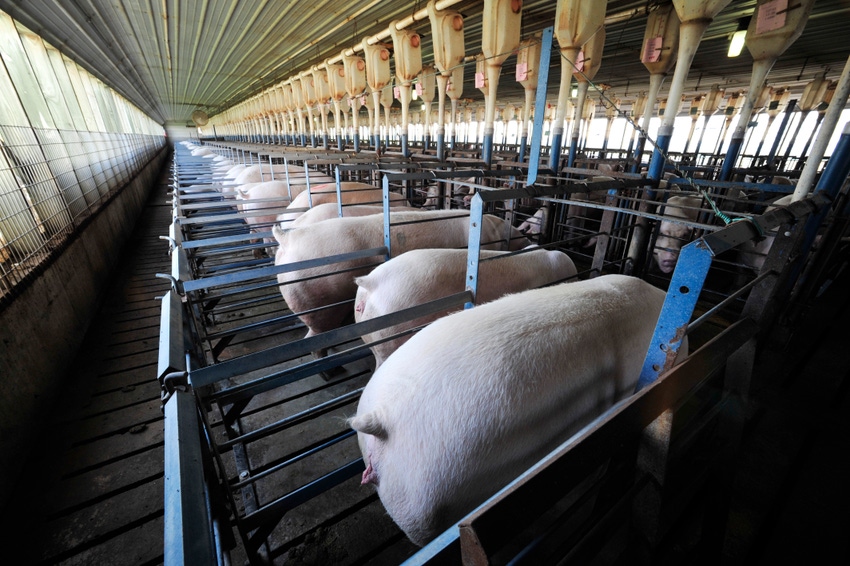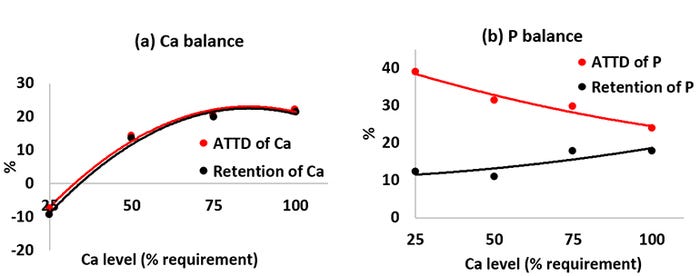Balance calcium effect on phosphorus in late-gestation sows’ diets
If dietary Ca is too low, bone tissue synthesis is impaired and some of the absorbed P is excreted in the urine even if P is not fed in excess of the requirement.
August 29, 2019

By Su A Lee and Hans H. Stein, University of Illinois
It has been demonstrated that a wide calcium-to-phosphorus ratio decreases P digestibility in growing pigs, which is likely a result of chelation of Ca and P in the intestinal tract of pigs. There are, however, fewer data for the digestibility of Ca and P in gestating sows than in growing pigs, but results of recent research demonstrated that digestibility of Ca and P is greater in late-gestation than in early or mid-gestation. This may be because relatively more Ca and P is needed for fetus development in late-gestation compared with earlier gestation periods, but requirements for digestible Ca in different periods of gestation have not been published.
Therefore, the objective of this experiment was to test the hypothesis that the concentration of Ca in diets fed to late-gestating sows affect the apparent total tract digestibility and retention of Ca and P.
Thirty-six gestating Camborough sows (PIC, Hendersonville, Tenn.; average parity = 2.8) were used. Four diets were fed to the 36 sows. Experimental diets were based on corn and soybean meal and diets were formulated to meet the requirement for gestating sows in late pregnancy for all nutrients except Ca. Phosphorus was included in all diets at the requirement (i.e., 0.56%, but Ca was included at 25%, 50%, 75% or 100% of the requirement. Thus, the four experimental diets were formulated to contain 0.18%, 0.36%, 0.54% or 0.72% Ca, and these concentrations were achieved by adding increasing concentrations of calcium carbonate to the diets at the expense of cornstarch.
Daily feed allowance was 1.5 times the maintenance energy requirement for gestating sows based on the body weight of sows. Daily feed allotments were provided in two equal meals. Water was available at all times. Sows were housed individually in metabolism crates from Day 91 to Day 105 of gestation, and feces and urine were quantitatively collected over a four-day period following five days of adaptation to the diets. The ATTD of Ca and P and Ca and P balances were calculated.
Results of the experiment indicated that the ATTD of Ca and retention of Ca increased (quadratic, P < 0.05) as Ca in diets increased (Figure 1), which is likely because the ATTD of Ca in a diet containing low Ca is influenced by a greater proportion of endogenous Ca in the feces than if dietary Ca is greater. A similar trend was observed for retention of Ca and this indicates that Ca was the limiting nutrient.

Fecal P output increased linearly (P < 0.05) as dietary Ca increased, which resulted in linear decreases for the ATTD of P. In contrast, urine P output decreased linearly (P < 0.05) as dietary Ca increased and a linear increase in P retention was also observed. The observation that the ATTD of P was reduced by increasing dietary Ca demonstrates that P likely gets chelated to Ca, which makes it undigestible and it is excreted in the feces instead of being absorbed.
The more Ca there is added to the diet, the more P gets chelated and that is why the ATTD of P is reduced with increasing concentrations of Ca in the diet. However, the observation that urine excretion of P was decreased and retention of P was increased by increasing dietary Ca indicated that bone synthesis also was increased with an increase in dietary Ca. Thus, the diets with low Ca resulted in Ca being the limiting nutrient for bone tissue synthesis and because of a lack of available Ca, some of the absorbed P was excreted in the urine. However, as more Ca became available for bone synthesis as dietary Ca increased, more P could also be retained in bone ash and that is the reason P retention increased even when P digestibility was reduced by the greater Ca levels.
In conclusion, increased dietary Ca decreases digestibility of P because of the interaction among Ca, P and phytate. However, if dietary Ca is too low, bone tissue synthesis is impaired and some of the absorbed P is excreted in the urine even if P is not fed in excess of the requirement. These results are in agreement with previous observations in growing pigs and demonstrate that it is important not to overfeed Ca in diets for sows. There is however, still a lack of data to determine the exact Ca requirement for gestating sows.
Sources: Su A Lee and Hans H. Stein, University of Illinois, who are solely responsible for the information provided, and wholly own the information. Informa Business Media and all its subsidiaries are not responsible for any of the content contained in this information asset.
You May Also Like



